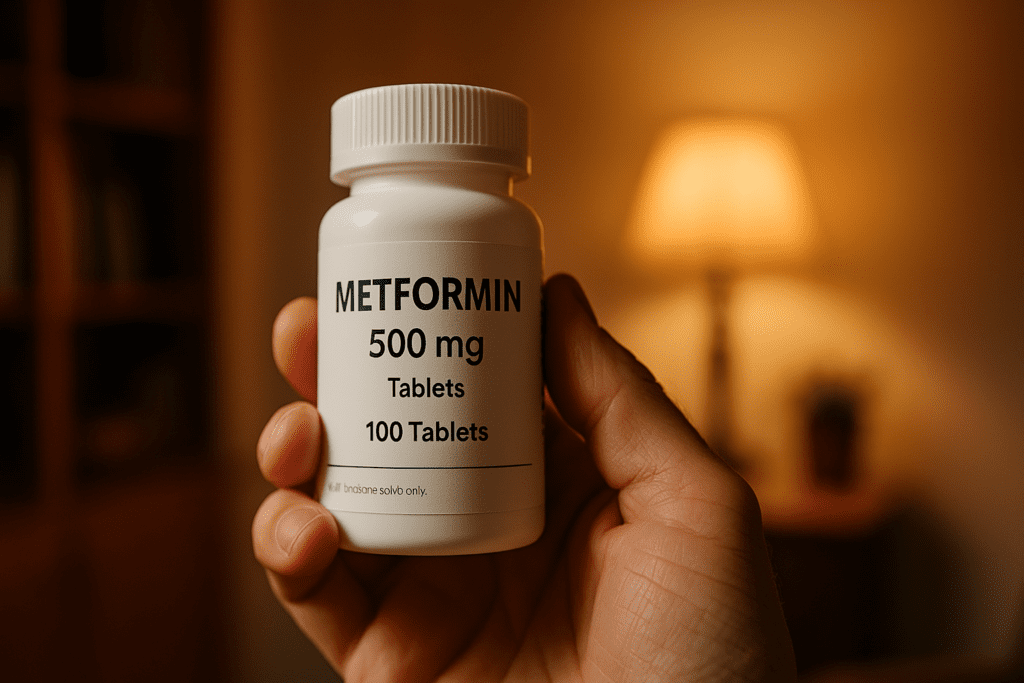Understanding the Role of Metformin in Modern Medicine
Metformin is one of the most prescribed medications for managing type 2 diabetes globally. Yet, despite its widespread use, many patients and even some healthcare professionals lack a deep understanding of the drug’s classification, how it works, and why it remains central in diabetes treatment protocols. As the science behind diabetes evolves, so too does the body of research illuminating the full capabilities and characteristics of metformin. By understanding what class of medication is metformin, clinicians and patients alike can better appreciate its efficacy, safety profile, and therapeutic versatility. The classification for metformin is not merely academic; it has real-world implications for how the drug is used, how it interacts with other treatments, and how emerging formulations, such as the metformin shot or metformin injection, may reshape the future of diabetes care.
You may also like: Breakthroughs in Current Diabetes Research: What the Latest Studies Reveal About Treatment and Prevention
What Class Is Metformin? A Look Into Its Drug Category
The class of drug metformin belongs to is known as “biguanides.” Biguanides are a relatively small group of compounds that work by decreasing glucose production in the liver, increasing insulin sensitivity, and enhancing peripheral glucose uptake. Within the metformin drug category, metformin stands out as the most prominent and clinically validated agent. Biguanides were initially developed in the 1920s, but due to toxicity concerns with earlier forms, metformin emerged as the safest and most effective representative of the class.
Understanding the metformin category class has implications beyond pharmacological classification. It offers insight into how the medication fits into treatment strategies for patients with insulin resistance, metabolic syndrome, and prediabetes. Furthermore, by exploring what class is metformin, healthcare professionals can distinguish its mechanism of action from that of sulfonylureas, SGLT2 inhibitors, or GLP-1 receptor agonists—helping tailor personalized therapies. In this context, classification for metformin isn’t just a label; it’s a roadmap guiding therapeutic decision-making.

How Metformin Works: Mechanisms Behind Its Efficacy
The effectiveness of metformin for diabetes type 2 stems from its multifaceted mechanism of action. Primarily, it acts on the liver to suppress gluconeogenesis, the metabolic process through which glucose is produced from non-carbohydrate sources. By inhibiting this process, metformin reduces the amount of glucose released into the bloodstream, particularly during fasting states. Additionally, metformin enhances insulin sensitivity in peripheral tissues, especially in skeletal muscle, allowing for more efficient glucose uptake.
Another lesser-known but crucial mechanism involves the gastrointestinal tract. Metformin alters the gut microbiota and affects intestinal glucose absorption, contributing to improved glycemic control. This gut-mediated effect is particularly significant because it suggests potential benefits beyond simple blood sugar regulation. For instance, the changes induced by metformin in gut flora may have secondary effects on inflammation, lipid metabolism, and even appetite regulation.
Recognizing how this metformin type medication operates allows providers to explain to patients why it rarely causes hypoglycemia, unlike insulin or sulfonylureas. Because it does not increase insulin secretion but rather improves the body’s response to existing insulin, it provides stable glycemic control with a lower risk of dangerous drops in blood sugar levels. This pharmacodynamic profile also plays a crucial role in determining drug interactions and the potential advantages of combining metformin with other diabetes therapies.
New Formulations: The Rise of the Metformin Shot and Injection
Historically, metformin has been administered orally, either as immediate-release or extended-release tablets. However, research into alternative delivery methods has led to the development of injectable formulations. The concept of a metformin injection or metformin shot is particularly appealing for patients who experience gastrointestinal side effects from oral tablets or have difficulties with pill compliance.
Early-stage clinical trials have demonstrated promising results with injectable metformin formulations. These injections aim to bypass the digestive tract, minimizing gastrointestinal upset and improving bioavailability. Patients who are needle-averse or have concerns about injections can still rely on oral forms, but the metformin shot offers an alternative for those seeking enhanced tolerability and convenience.
The development of a metformin injection represents a broader shift in pharmaceutical science, where drug delivery is being tailored to individual patient needs. This innovation reinforces the importance of knowing the class of drug metformin represents, as it informs how new formulations can maintain the same therapeutic mechanisms while improving patient experience. For example, although the route of administration may change, the drug still functions within the biguanide category, targeting hepatic glucose production and enhancing insulin sensitivity.
Metformin for Diabetes Type 2: A Cornerstone in Chronic Disease Management
The use of metformin for diabetes type 2 has long been the gold standard for first-line pharmacologic intervention. Its widespread adoption is supported by extensive clinical data showing consistent reductions in HbA1c levels, improved insulin sensitivity, and a favorable safety profile. What makes metformin uniquely valuable is its proven effectiveness in diverse populations and across various stages of disease progression.
Patients newly diagnosed with type 2 diabetes often begin treatment with lifestyle changes and metformin. Because it is a metformin type medication that doesn’t promote weight gain or hypoglycemia, it pairs well with dietary interventions and physical activity. Moreover, it sets a strong foundation for later combination therapies if needed. In cases where blood sugar control becomes more challenging, metformin can be safely combined with newer agents like DPP-4 inhibitors, SGLT2 inhibitors, or insulin.
Understanding the metformin drug category is vital when designing long-term treatment plans. Since the drug operates differently from others in the diabetes pharmacopeia, it can be a foundational therapy even when additional medications are introduced. Providers must also be mindful of contraindications such as renal impairment, where metformin use must be monitored carefully to avoid rare but serious complications like lactic acidosis.

Metformin Beyond Glycemic Control: Emerging Benefits and Research Trends
Ongoing research into metformin has revealed a broader spectrum of potential benefits, extending beyond its original purpose of glycemic control. For example, metformin is currently being investigated for its role in cancer prevention, particularly in reducing the risk of colorectal, breast, and pancreatic cancers. Although the evidence is still emerging, initial studies suggest that metformin’s impact on insulin signaling pathways and inflammation could translate into anticancer properties.
Another fascinating area of exploration is metformin’s potential to delay the onset of age-related diseases. Some researchers believe that because the drug modulates mitochondrial function and reduces oxidative stress, it could serve as an anti-aging agent. This has sparked interest in off-label uses of the medication, prompting ethical and regulatory discussions around long-term use in non-diabetic populations.
While such possibilities are exciting, it’s important to return to the foundation: understanding what class of medication is metformin and why its mechanism supports these broader effects. Being part of the biguanide class, metformin influences systemic metabolic processes, not just blood glucose. This systemic influence may help explain its observed effects on cardiovascular health, cognitive function, and even fertility in women with polycystic ovary syndrome (PCOS).
Classification for Metformin: Why It Matters in Clinical Practice
From a clinical standpoint, knowing the classification for metformin helps healthcare providers better anticipate drug interactions, contraindications, and synergistic effects with other therapies. For instance, unlike insulin or sulfonylureas, which directly increase insulin levels, metformin reduces the liver’s glucose output without impacting pancreatic beta-cell function. This difference informs decisions about drug pairing and helps prevent overlapping side effects.
Moreover, categorizing metformin correctly allows pharmacists and prescribers to communicate more clearly with patients. When discussing the metformin category class, it becomes easier to explain why some patients experience gastrointestinal symptoms, why it doesn’t cause low blood sugar on its own, and why it remains a cornerstone even as newer therapies emerge. Such clarity is critical for promoting adherence and empowering patients in their self-care.
Understanding the class of drug metformin belongs to also impacts guidelines and insurance coverage. Many clinical guidelines emphasize using medications from different classes to achieve complementary effects. As such, prescribing metformin alongside drugs from other categories ensures a more comprehensive approach to managing type 2 diabetes.
Safety, Side Effects, and Contraindications: What Patients Should Know
While metformin is generally well tolerated, it is not without potential side effects. The most common complaints are gastrointestinal in nature, including nausea, diarrhea, and abdominal discomfort. These are typically more pronounced with the immediate-release form and can often be mitigated by taking the medication with meals or switching to the extended-release formulation.
More serious but rare side effects include lactic acidosis, a potentially life-threatening condition associated with the accumulation of lactic acid in the blood. This risk is higher in patients with significant renal impairment, which is why kidney function must be assessed before starting metformin and monitored regularly during treatment. Despite this rare complication, the overall risk profile of metformin remains highly favorable.
For patients exploring newer formulations like the metformin shot, safety evaluations are ongoing. Early studies suggest that bypassing the gastrointestinal tract may reduce the incidence of digestive side effects, making the metformin injection an appealing alternative for certain patients. Regardless of the form, understanding what class is metformin reminds us that despite its benefits, responsible prescribing must always account for patient-specific factors and comorbidities.
Patient-Centered Care and the Importance of Education
Empowering patients with knowledge about their medications significantly enhances adherence, outcomes, and quality of life. When patients understand that they are taking a metformin type medication within the biguanide class, they gain insight into how the drug works and what to expect from its use. Education can dispel myths, reduce fear, and encourage proactive communication between patients and providers.
For example, some patients mistakenly believe that all diabetes medications carry a high risk of hypoglycemia. Clarifying that metformin, due to its mechanism of action, does not usually cause this side effect can increase patient confidence in managing their condition. Furthermore, for individuals considering alternative formulations like a metformin shot or injection, understanding the rationale behind such options can support informed decision-making.
Healthcare professionals must also stay current with the evolving landscape of diabetes care. As research continues to explore the broader applications of metformin, from cancer prevention to longevity, clinicians should be prepared to discuss these developments with patients. Accurate classification for metformin enables such discussions to be grounded in science rather than speculation.

Frequently Asked Questions About the Metformin Drug Category and Its Role in Type 2 Diabetes Treatment
1. How might the future of the metformin shot change diabetes care delivery?
The development of the metformin shot opens new doors for personalized diabetes care, especially for patients with difficulty tolerating oral formulations. Unlike traditional tablets that must pass through the gastrointestinal tract, the injectable form delivers metformin directly into the bloodstream, potentially improving absorption and reducing side effects such as nausea or diarrhea. Moreover, a metformin injection could offer greater precision in dosing, which may prove beneficial for individuals requiring tight glycemic control. In the long term, this advancement could lead to more accessible depot formulations, where one injection lasts several days or even weeks. As the healthcare landscape increasingly emphasizes convenience and compliance, injectable delivery of metformin type medication may redefine chronic disease management.
2. What makes the class of drug metformin unique compared to other diabetes medications?
What distinguishes the class of drug metformin, namely the biguanides, is its ability to lower blood glucose levels without stimulating insulin secretion. Unlike sulfonylureas or insulin therapy, metformin does not directly affect pancreatic beta cells, which significantly lowers the risk of hypoglycemia. Furthermore, biguanides like metformin primarily act on the liver and gut, targeting hepatic glucose production and intestinal glucose absorption. This extrapancreatic mechanism grants the metformin drug category a unique safety profile that makes it ideal for early-stage type 2 diabetes. As more therapies emerge, the foundational role of this class remains relevant because of its ability to complement newer agents without overlapping mechanisms.
3. Can the classification for metformin affect its use in special populations, such as older adults or those with multiple chronic conditions?
Yes, the classification for metformin has practical implications for populations with complex medical needs. For older adults, metformin’s biguanide classification provides reassurance due to its minimal risk of hypoglycemia, a common concern in geriatric medicine. However, age-related renal decline must be considered, as impaired kidney function can increase the risk of lactic acidosis. In patients with multiple comorbidities, knowing what class of medication is metformin helps healthcare professionals design safer polypharmacy strategies. For instance, when paired with SGLT2 inhibitors, the complementary actions of each class reduce blood glucose via different pathways while mitigating overlapping side effects.
4. How is the metformin category class being evaluated for uses beyond diabetes?
Recent studies are pushing the boundaries of the metformin category class into exciting territories beyond glycemic control. Researchers are exploring metformin’s potential in slowing cellular aging through its impact on mitochondrial respiration and inflammation pathways. Trials like the TAME (Targeting Aging with Metformin) study aim to understand how this metformin type medication may extend healthspan by delaying age-related diseases. There’s also growing interest in its neuroprotective effects, particularly in preventing or slowing cognitive decline in patients at risk for Alzheimer’s disease. As a result, the classification for metformin is no longer limited to endocrinology but is now influencing research in geriatrics, oncology, and neurology.
5. How can patients advocate for newer formulations like a metformin injection if they experience side effects from tablets?
Patients experiencing significant gastrointestinal discomfort with oral metformin should discuss alternative formulations, including the emerging metformin injection, with their healthcare providers. While still under investigation, these injectable options offer promise for those who cannot tolerate the drug orally due to nausea, bloating, or diarrhea. Bringing clinical trial findings or recent research to appointments may help patients advocate more effectively for novel treatment approaches. Additionally, patients can seek care from diabetes specialists familiar with cutting-edge therapies who may be more receptive to considering the metformin shot. As access improves, being an informed and proactive participant in treatment decisions will be key to leveraging the full potential of this metformin type medication.
6. What role does the metformin drug category play in reducing long-term diabetes complications?
The metformin drug category plays a vital role in mitigating long-term complications by addressing the root metabolic dysfunctions of type 2 diabetes. Through its actions on hepatic glucose production and peripheral insulin sensitivity, metformin helps reduce chronic hyperglycemia—a major contributor to cardiovascular disease, neuropathy, and retinopathy. Clinical studies have also shown reductions in inflammatory markers and lipid levels in patients using metformin, which may contribute to its cardiovascular protective effects. Because it does not cause weight gain and can even support modest weight loss, it also indirectly improves outcomes in patients with obesity-related comorbidities. Thus, the classification for metformin as a biguanide is directly tied to its effectiveness in altering the trajectory of type 2 diabetes progression.
7. How does understanding what class is metformin help guide combination therapy choices?
Recognizing what class is metformin can significantly enhance the safety and effectiveness of combination therapies. Metformin, as a biguanide, works independently of insulin secretion, making it ideal to pair with drugs that do stimulate insulin production, such as GLP-1 receptor agonists or DPP-4 inhibitors. This reduces the risk of overlapping side effects and creates synergistic benefits in glycemic control. Understanding that metformin is a foundational agent in its class also empowers clinicians to retain it in multi-drug regimens while layering other agents as needed. When facing treatment-resistant diabetes, revisiting the role of metformin in combination with different classes allows for more strategic pharmacologic planning.
8. Are there any behavioral or psychological benefits linked to metformin use in managing type 2 diabetes?
Although often overlooked, the behavioral and psychological benefits of using metformin for diabetes type 2 can be substantial. For many patients, starting with a well-tolerated medication like metformin reduces the emotional burden of diagnosis, especially when the fear of insulin injections or hypoglycemia looms large. By improving blood glucose control without complicated dosing schedules, metformin can empower patients to adhere to treatment and engage more confidently in lifestyle changes. Moreover, emerging research suggests that metformin may influence neuroinflammation and insulin signaling in the brain, potentially offering benefits for mood regulation. These lesser-known effects add depth to our understanding of the metformin drug category and its holistic impact on patient wellness.
9. What innovations are underway to improve the delivery of metformin type medication?
Pharmaceutical researchers are actively exploring novel delivery systems for metformin type medication, including transdermal patches, inhalable powders, and sustained-release injectable depots. One goal is to enhance drug absorption while minimizing gastrointestinal exposure, which would benefit patients with chronic GI issues. These innovations align with a broader movement in chronic disease care toward longer-acting, less invasive treatment options. The development of the metformin shot reflects this shift, offering not only relief from GI symptoms but also potentially improved pharmacokinetics. As delivery methods diversify, it will become increasingly important for clinicians to understand the metformin category class and its pharmacological characteristics to match patients with the most appropriate formulation.
10. How does public perception influence the adoption of newer options like the metformin shot or injection?
Public perception plays a surprisingly important role in the adoption of new treatment modalities such as the metformin shot. Many patients still view injections as a last resort or associate them with insulin dependence, which may create hesitation. Overcoming these misconceptions requires healthcare providers to communicate that a metformin injection is not an escalation of disease severity, but rather a refinement in delivery method aimed at improving tolerance and convenience. Greater visibility in patient education campaigns, testimonials, and physician endorsements could shift attitudes and make these alternatives more mainstream. As the class of drug metformin continues to evolve, reshaping perceptions around innovation will be key to broader acceptance and better patient outcomes.
Conclusion: Why Understanding the Metformin Drug Category Matters Now More Than Ever
As the medical field continues to evolve, the importance of foundational knowledge cannot be overstated. Knowing what class of medication is metformin and how it functions within the broader metformin drug category is more than just an academic exercise—it’s a critical component of patient-centered care, clinical decision-making, and pharmaceutical innovation. Whether considering traditional oral tablets or newer delivery systems like the metformin injection, healthcare providers and patients alike benefit from understanding the full scope of what this drug can offer.
The classification for metformin as a biguanide underscores its unique mechanism, low risk of hypoglycemia, and compatibility with other diabetes medications. It also helps contextualize its expanding role in treating conditions beyond diabetes, such as PCOS, cancer, and potentially even aging-related decline. By appreciating the metformin category class, clinicians can confidently navigate its use in both established and emerging therapeutic scenarios.
Ultimately, as personalized medicine becomes the norm and patients demand more tailored, evidence-based care, understanding the class of drug metformin belongs to provides a foundation for smarter, safer, and more effective treatment strategies. The journey of metformin—from oral pill to metformin shot—mirrors the broader transformation of modern healthcare, where classification meets innovation and science empowers better outcomes.
diabetes medication guide, blood sugar management tips, insulin resistance treatment, non-insulin diabetes drugs, glucose-lowering therapies, diabetes prevention strategies, type 2 diabetes care, chronic disease management, biguanide mechanism of action, hepatic glucose regulation, anti-aging drug research, PCOS and insulin sensitivity, cardiovascular benefits of diabetes drugs, metabolic health support, personalized diabetes treatment, oral hypoglycemic agents, diabetes pharmacology explained, future of diabetes medications, innovative drug delivery systems, gut microbiome and diabetes
Further Reading:
Metformin: Is it a drug for all reasons and diseases?
Disclaimer
The information contained in this article is provided for general informational purposes only and is not intended to serve as medical, legal, or professional advice. While MedNewsPedia strives to present accurate, up-to-date, and reliable content, no warranty or guarantee, expressed or implied, is made regarding the completeness, accuracy, or adequacy of the information provided. Readers are strongly advised to seek the guidance of a qualified healthcare provider or other relevant professionals before acting on any information contained in this article. MedNewsPedia, its authors, editors, and contributors expressly disclaim any liability for any damages, losses, or consequences arising directly or indirectly from the use, interpretation, or reliance on any information presented herein. The views and opinions expressed in this article are those of the author(s) and do not necessarily reflect the official policies or positions of MedNewsPedia.


